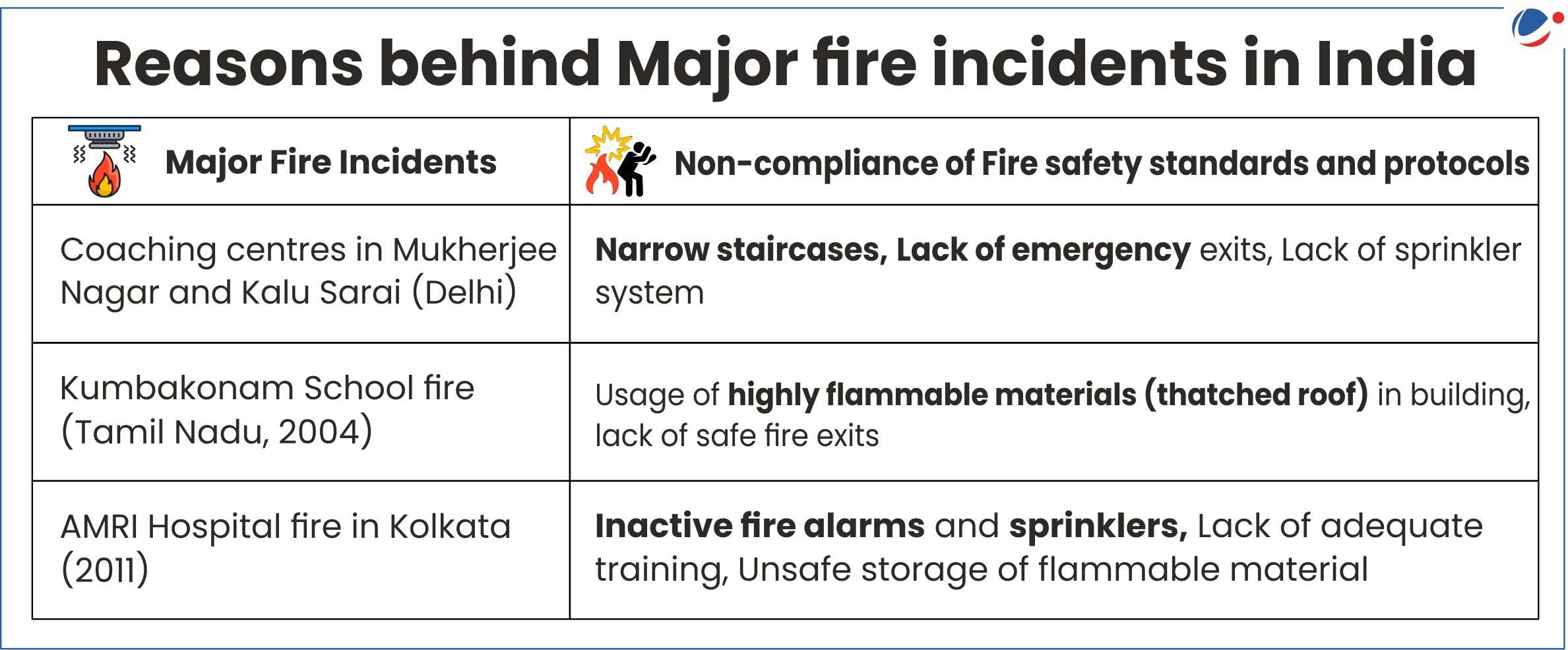Why in the news?
Recent fire accidents in a gaming zone in Rajkot (Gujarat), a firecracker factory in Harda (Madhya Pradesh) and a private hospital in Delhi have raised concerns over fire safety in India.
More on the news
- As per National Crime Records Bureau (NCRB) report 2022, 7,435 people were killed in over 7,500 fire accidents in India in 2022.
- ~800 factory fires were recorded in the last two years in Delhi alone.
- Key reasons for such fires include violation of fire-safety norms, human negligence, electrical malfunctions, Industrial Accidents, etc.
Existing Fire Safety Standards and Regulations in India
- Constitutional provisions: Fire service is a State subject and included in the 12th Schedule of the Constitution of India which specifies the powers, authority and responsibilities of Municipalities.
- State governments are responsible for fire prevention and for implementing safety measures through the State Fire Services Act or building bylaws.
- National Building Code (NBC): Published by Bureau of Indian Standards (BIS) in 1970 and updated in 2016, it acts as the central standard for fire safety in India and provides guidelines regarding the general construction requirements, maintenance, exit routes and fire safety of buildings.
- It is a mandatory requirement for State governments to incorporate the NBC recommendations on minimum fire safety and rescue measures into their local bylaws.
- Model Building Bye Laws 2016: Ministry of Housing and Urban Affairs issued it as a guide to the States and UTs to frame their respective building bylaws.
- Model Bill to Provide for the Maintenance of Fire and Emergency Service for the State, 2019: It provides a model framework for states for maintenance of fire and emergency service.
- Fire and Life Safety guidelines: Circulated by the Ministry of Health in 2020, stipulating third party accreditation for fire safety, creation of Fire Response Plan (FRP), etc.
- Scheme for Expansion and Modernization of Fire Services in the States: Launched by Centre in 2023 for strengthening fire services in the States for the period upto 2025-26.
Challenges in maintaining Fire Safety Standards
- Absence of uniform safety legislation across states:
- Some major states like Rajasthan, Madhya Pradesh and Jharkhand are yet to enact any legislation on fire safety.
- Majority of states have not updated or amended their existing laws in line with the Model Fire Act, 2019.
- NBC provisions, including 'Fire and Life Safety' audits, are recommendatory in nature and are not being implemented uniformly across India.
- Suboptimal government oversight: Fire safety guidelines are not enforced properly due to failure of local bodies to conduct regular checks, poor quality of inspections, rare follow up actions, corruption etc.
- Shortage of staff and proper firefighting equipment: Resource constraints among local bodies affect the performance of the state fire safety department.
- In 2019, there was a shortage of 5,191 fire stations and 5,03,365 personnel than required.
- Other Shortcomings: Lenient punishments and penalties for violation of fire safety standards; Lack of proper organisational structure of fire safety Departments; Inadequate training and career progression of personnel; Lack of Infrastructural facilities etc.
- Challenges related to Urbanisation:
- High population density: It increases the risk of casualties and complicates evacuation during fire incidents. E.g., the 1997 Uphaar Cinema fire in Delhi, where overcrowding led to a deadly stampede.
- Poor Urban Planning: Congested urban layout with narrow lanes delay arrival of fire engines, affect rescue operations. E.g., Kamala mills fire in Mumbai 2017.
- Non-compliance: Several major fire incidents resulted from violations of fire safety standards by builders, private entities, etc.

Way forward
- Mandatory Fire Safety Audits to be conducted annually by third-party nationwide for buildings with large footfalls.
- Hazard Identification & Risk Assessment (HIRA) with focus on identifying potential hazards to address and mitigate inherent fire hazards.
- Implement 13th Finance Commission Recommendations:
- Municipal Corporations with populations over one million must develop fire hazard response and mitigation plans and revamp fire services and support State Fire Services Departments.
- Greater awareness through regular Fire Safety Drills in residential colonies, schools, and other institutions.
- Stricter enforcement of fire safety standards and severe punishment for violations.
- Strengthening capacity of local bodies by enhancing allocation of funds for fire departments, adequate training for fire personnels etc.
- Implementing National Disaster Management Authority (NDMA) Guidelines on Scaling, Type of Equipment and Training of Fire Services
NDMA Guidelines
|







